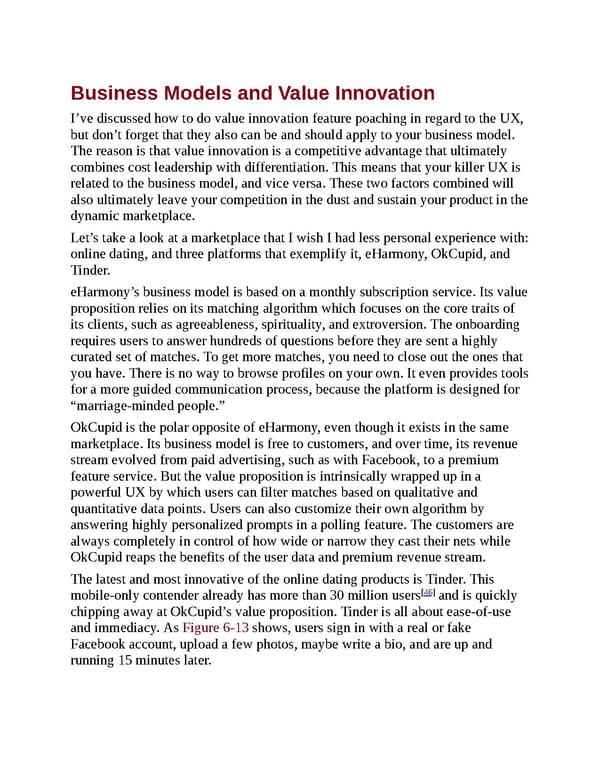Business Models and Value Innovation I’ve discussed how to do value innovation feature poaching in regard to the UX, but don’t forget that they also can be and should apply to your business model. The reason is that value innovation is a competitive advantage that ultimately combines cost leadership with differentiation. This means that your killer UX is related to the business model, and vice versa. These two factors combined will also ultimately leave your competition in the dust and sustain your product in the dynamic marketplace. Let’s take a look at a marketplace that I wish I had less personal experience with: online dating, and three platforms that exemplify it, eHarmony, OkCupid, and Tinder. eHarmony’s business model is based on a monthly subscription service. Its value proposition relies on its matching algorithm which focuses on the core traits of its clients, such as agreeableness, spirituality, and extroversion. The onboarding requires users to answer hundreds of questions before they are sent a highly curated set of matches. To get more matches, you need to close out the ones that you have. There is no way to browse profiles on your own. It even provides tools for a more guided communication process, because the platform is designed for “marriage-minded people.” OkCupid is the polar opposite of eHarmony, even though it exists in the same marketplace. Its business model is free to customers, and over time, its revenue stream evolved from paid advertising, such as with Facebook, to a premium feature service. But the value proposition is intrinsically wrapped up in a powerful UX by which users can filter matches based on qualitative and quantitative data points. Users can also customize their own algorithm by answering highly personalized prompts in a polling feature. The customers are always completely in control of how wide or narrow they cast their nets while OkCupid reaps the benefits of the user data and premium revenue stream. The latest and most innovative of the online dating products is Tinder. This [46] mobile-only contender already has more than 30 million users and is quickly chipping away at OkCupid’s value proposition. Tinder is all about ease-of-use and immediacy. As Figure 6-13 shows, users sign in with a real or fake Facebook account, upload a few photos, maybe write a bio, and are up and running 15 minutes later.
 UX Strategy: How to Devise Innovative Digital Products that People Want Page 164 Page 166
UX Strategy: How to Devise Innovative Digital Products that People Want Page 164 Page 166